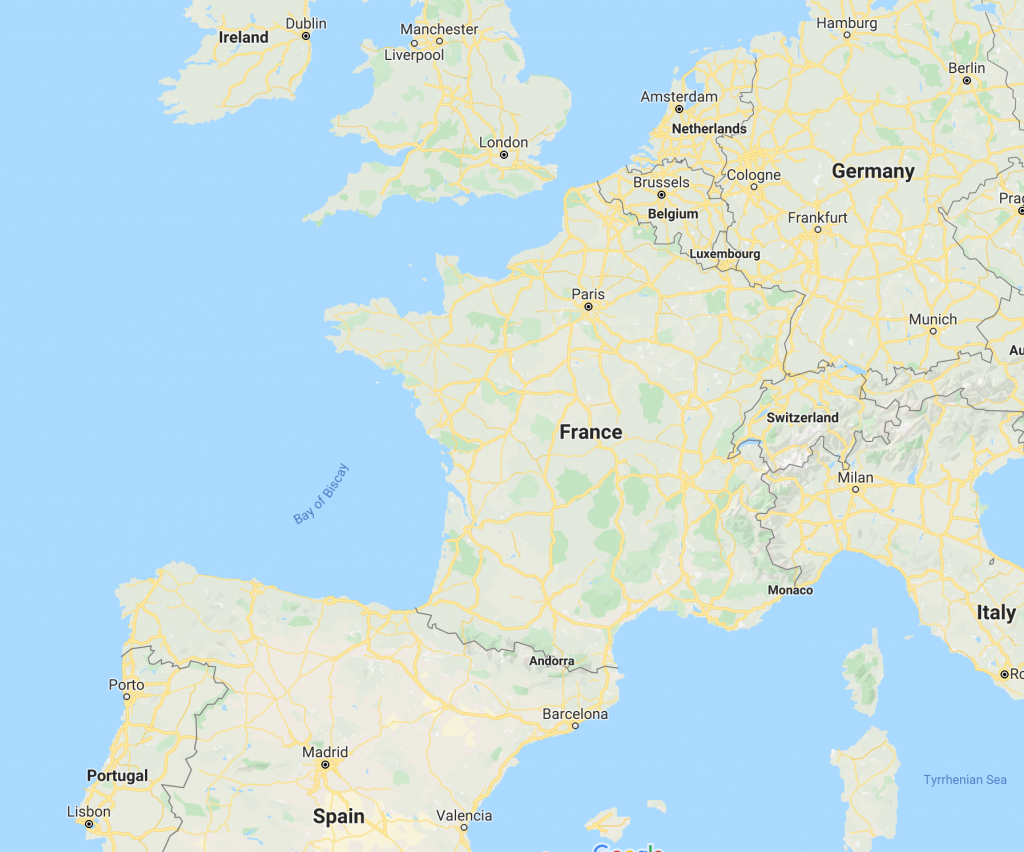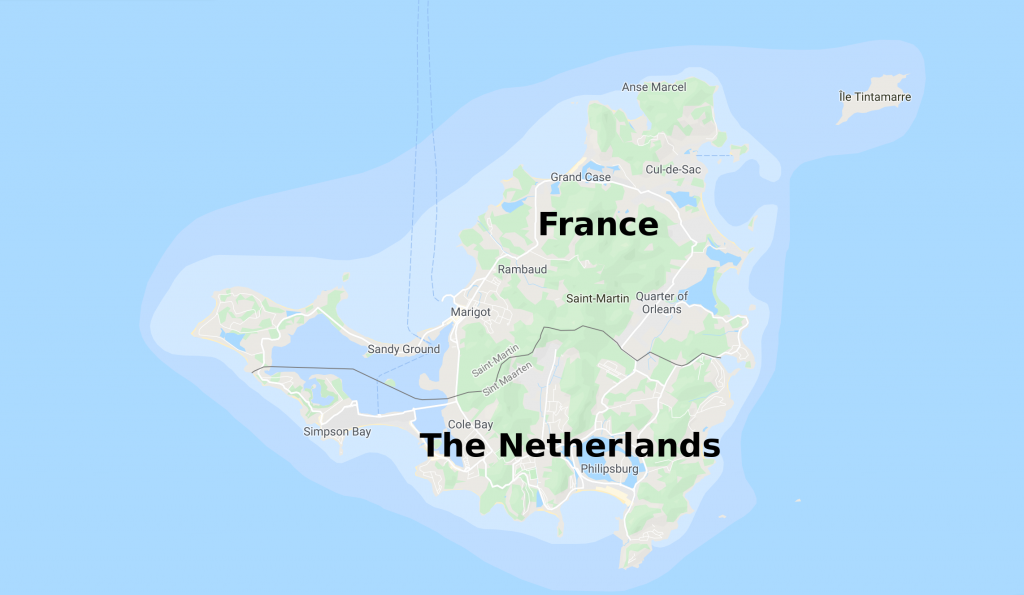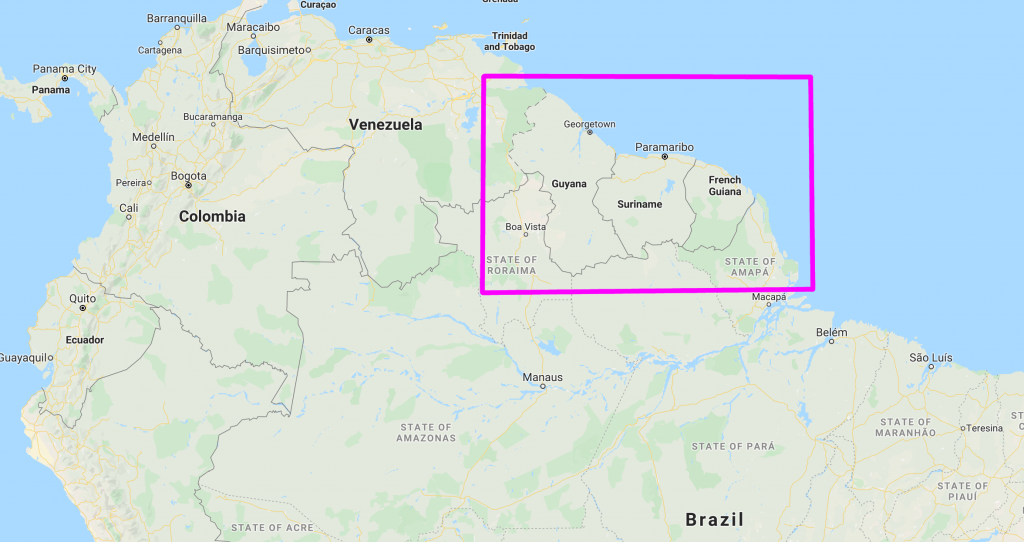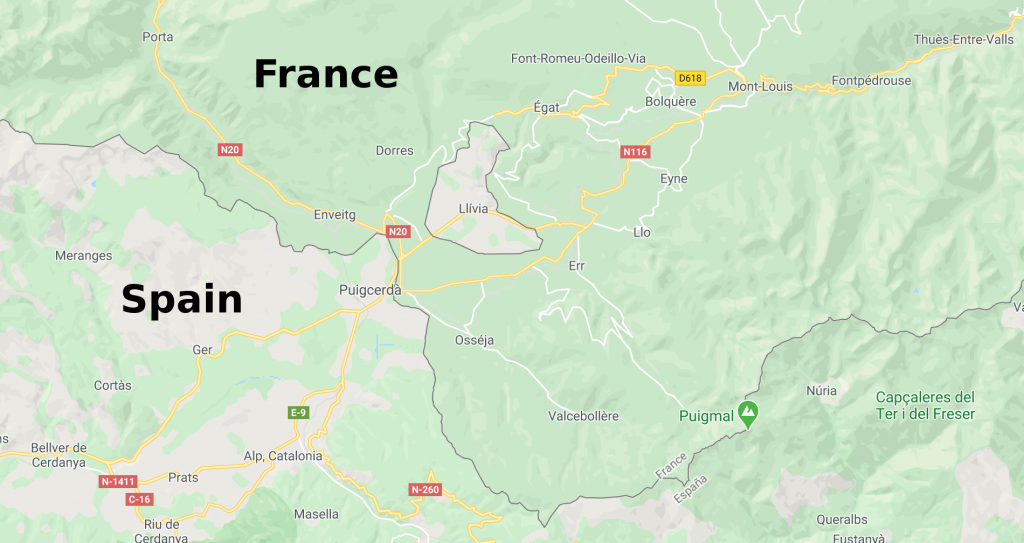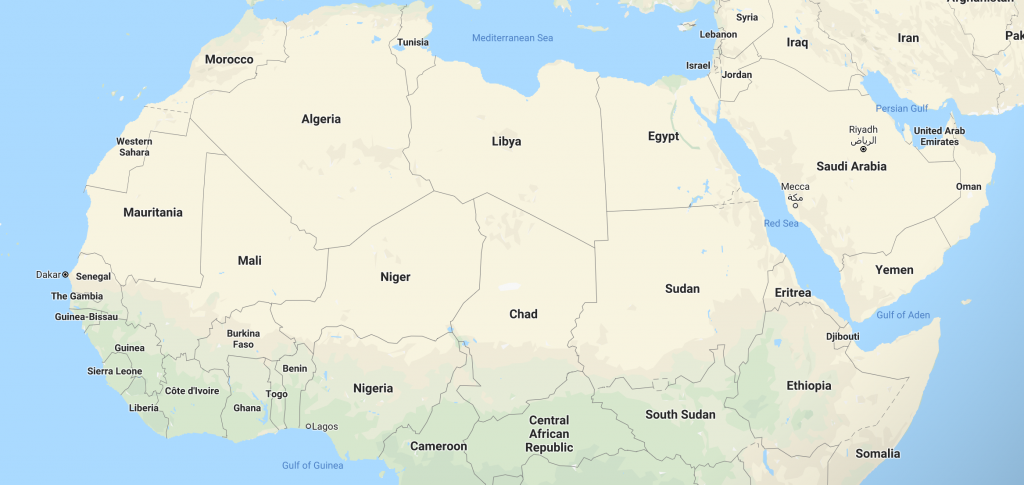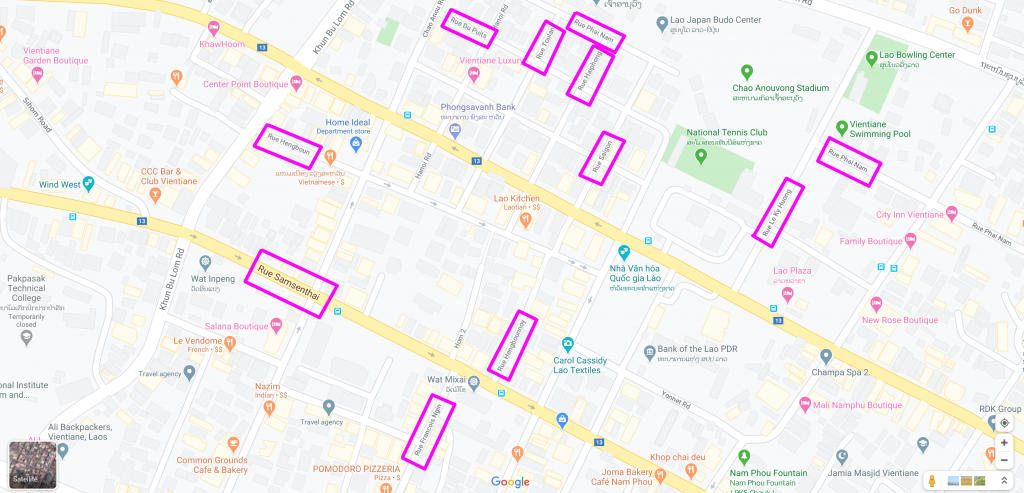Welcome back to my Weird Geography series. After looking at some of the quirkier sides of Mexico’s geography last time, today we’ll travel to France, another country with plenty of geographical oddities. I spent 11 years studying the French language and French culture while I was in school, and have visited France without ever having stepped foot in Europe, so I have seen these peculiarities first-hand. If you want to know how I did it, the answer is at the end of this post. In the meantime, let’s jump right in.
1. Contrary to Popular Belief, France Borders 8 Other Countries
When you think of countries that border France, I’m guessing that Spain, Italy, Germany, and Belgium are among the first neighboring countries that come to mind. While those 4 countries do take up the majority of France’s land borders, France also borders numerous smaller countries such as Monaco and Andorra. The complete list of countries that border France is:
Now, despite the fact that the map says otherwise…
2. France Shares a Border with the Netherlands
No, your eyes are not playing tricks on you. There are no weird gotchas in the map above. On the European continent, France does not border the Netherlands. However, in the Caribbean, sitting about 150 km (90 mi) east of both the US and British Virgin Islands is the island of St. Martin. The northern half of the island is a territory of France (Saint-Martin), while the southern half of the island is a territory of the Netherlands (Sint Maarten).
If that wasn’t strange enough on the border front…
3. France Also Shares a Border with Brazil
When you think of South America, Latin and Hispanic culture is always the first thing that comes to mind. As it should be. Nearly the entire continent speaks either Spanish or Portuguese. However, three small outliers sit on the north coast of South America, wedged between Venezuela and Brazil.
Going from west to east, those three outliers are:
- Guyana – an English-speaking country and former British territory.
- Suriname – a Dutch-speaking country and former territory of the Netherlands.
- French Guiana – currently an overseas department, or territory, of France.
All right, enough with French territories for now. Let’s head back to Europe.
4. You can visit Spain without leaving France
Thanks to an anomaly in the border between France and Spain and the European Union’s laws that allow you to freely move between countries, you can visit Spain without having to cross France’s southern border.
Located about 2 km north of the border crossing between Bourg-Madame, France and Puigcerdà, Spain, you’ll find the town of Llívia, a Spanish town located entirely inside of France. Spain originally ceded the village to France in 1659 as part of the Treaty of the Pyrenees, but bureaucratic oversight kept it officially as part of Spain, where it remains to this day.
Today, Llívia is steeped in history that goes back to the Middle Ages. It is a great place to go indulge in Spanish architecture, culture, and cuisine. Over the years, Llívia has maintained its Spanish heritage despite strong French influences from being surrounded by France.
Because both France and Spain are members of the European Union, you can easily pass through town without even realizing you were in another country. Unlike some other enclaves, Llívia has Spanish dialing codes, postal codes, and emergency services.
Feel free to read more about Llívia in the Spanish newspaper El País.
5. You can drive from Paris, France to London, England without having to get on a boat
While you certainly have the option to get on a boat if you wish, you can also opt to take the train through Channel Tunnel (Le tunnel sous la manche) between Folkestone, England and Calais, France. The 50 km (31 mi) tunnel is the only fixed link between the UK and mainland Europe and is the longest underwater tunnel in the world.
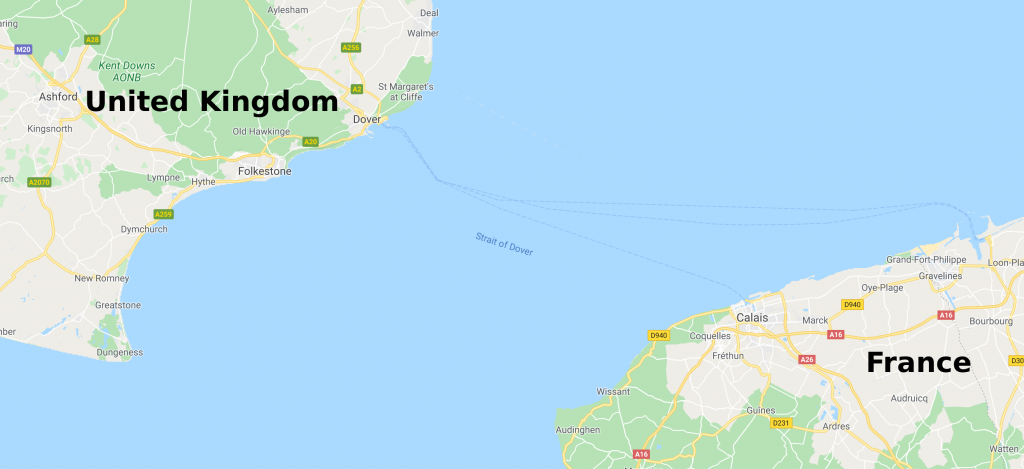
The tunnel first opened in 1994, facilitating a direct connection between high-speed railways in the UK and France. Trains travel through the tunnel at 160 km/h (99 mph), making it much faster than ferries. In 2017, the tunnel carried 10.3 million passengers, 10.4 million passenger cars, and 1.22 million tons of freight.
Now, let’s dive into French culture…
6. The world’s most populous French-speaking city is not in France
If I asked you what is the biggest French-speaking city in the world, your first guess would likely be Paris. When I told you that wasn’t correct, you’d probably start guessing other French cities such as Lyon, Marseille, and Toulouse. Nope. I’ll give you a hint. It’s not in France. You’ll tell me it’s Montréal, and I’ll once again tell you you’re wrong.
Paris was the world’s most populous French-speaking city until the mid 2010’s. In 2015, Kinshasa, the capital of the Democratic Republic of the Congo, passed Paris to become the most populous French-speaking city in the world and the most populous city on the African continent.
Here are the 5 most populous French-speaking cities in the world, as of 2017:
- Kinshasa, DR Congo – 11.58 million
- Paris, France – 10.85 million
- Abidjan, Côte d’Ivoire – 4.8 million
- Montréal, Québec, Canada – 3.54 million
- Dakar, Sénégal – 3.52 million
Booming populations in Francophone Africa are driving the shift in demographics and turning parts of Africa into centers for innovation. As a result, you are seeing the rise megacities such as Kinshasa, Abidjan, and Dakar all over French-speaking Africa.
7. Besides English, the most common second language you’ll find in French-speaking countries is Arabic
While your initial instinct would probably be to guess Spanish or Italian here, I’ll direct your attention back to the last point where we discussed the boom across Francophone Africa, and more specifically, northern Africa. Across many of the countries that make up the Sahara Desert, Arab culture has been and continues to merge with a booming French-speaking Africa.
As a result, many countries now speak both French and Arabic. Some countries such as Morocco, Algeria, Tunisia, and Mauritania use Arabic as their primary language and French as their secondary languages. Others, such as Senegal, Niger, and the Central African Republic do the opposite, primarily speaking French, while using Arabic as a secondary language.
Here are the most common second languages in French-speaking countries:
- English – 11 countries
- Arabic – 9 countries
- German – 3 countries
- Wolof – 2 countries
- Spanish – 2 countries
8. French is spoken as an official or primary unofficial language on every continent
While it’s easy to identify French-speaking countries, states, and territories on continents such as Europe, Africa, and North America, I want to focus on the lesser-known places. France’s extensive network of territories and former colonies have left the French language and culture dotted all over the world.
Let’s start in South America. If you remember earlier, the French territory of French Guiana sits on the north coast of the continent between Brazil and Venezuela. French Guiana shares the same vibrant Creole culture you’ll find across the French Caribbean, such as in places like Haiti, Martinique, and Guadeloupe. It’s part of France, so its official language is French.
French language and culture in Asia is quickly dying out, but if you know what to look for, you can still find it. From 1887 to 1954, French Indochina was comprised of what is currently Vietnam, Cambodia, and Laos. After French Indochina was granted independence from France, it retained its French culture and language similar to Francophone Africa. However, it has since faded into a distant memory as those countries restore their native culture, as they have much smaller connection to Europe than French-speaking Africa.
While fewer and fewer people in Cambodia, Laos, and Vietnam are speaking French, they still do, albeit not to a very large extent. Some of the best remaining evidence of French influence in southeast Asia can actually be found on Google Maps (click the image to enlarge).
And Oceania? That’s a perfect segue into our next fact.
9. From Australia, you can travel round-trip to France and cover less distance than if you flew one-way from Paris to Moscow
France’s territories strike again, here. About 1,200 km (800 mi) off the coast of Australia’s Queensland state, you will find the island of New Caledonia (Novelle Calédonie), the southernmost French territory in the South Pacific. The island is a top snorkeling and scuba diving location, well known for its pristine beaches, stunning lagoons, expansive coral reefs, and diverse flora and fauna. It is also rich in both Polynesian and French culture.

And as for the distance from Paris to Moscow? It’s about 2,500 km (1,500 mi) as the crow flies.
10. You can get on a ferry in Canada and be in France 80 minutes later
Have you ever seen the tourism ads for Canada that tell people that they can experience Europe without leaving North America? They’re usually inviting you to come experience the strong European influences in cities such as Montréal and Québec City (La Ville Québec).
It turns out you can take that a step further and actually visit Europe without ever leaving North America. About 25 km (15 mi) west of Point May, Newfoundland and Labrador, Canada, you will find the French territory of St. Pierre and Miquelon.
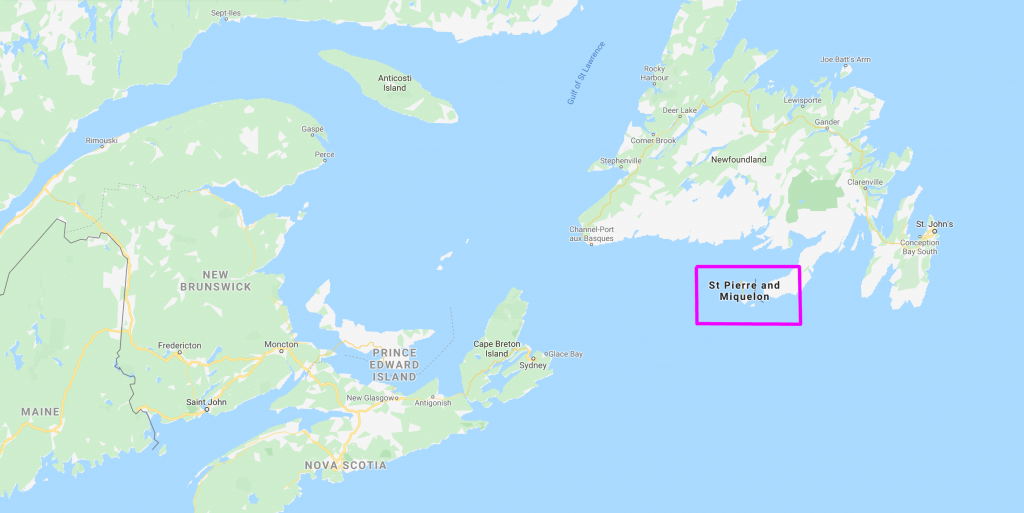
St. Pierre and Miquelon may be small islands, but they carry a stark cultural distinction not just from Newfoundland and Labrador, but to Canada as a whole. When you visit the islands, you’ll experience French food, wine, and music. You’ll pay with Euros, charge your devices with 220 volt plugs, and of course will be speaking French, not English. Finally, St. Pierre and Miquelon are part of France, so don’t forget your passport.
Fun Fact: Because of its proximity to St. Pierre and Miquelon, Newfoundland is the only place in North America where you’ll see cars with European license plates on a regular basis.
Bonus: The French city of Nice, with its palm tree-lined boulevards, sits at the same latitude as Toronto, Ontario, Canada
Despite the stark differences in climate, both cities sit at 43°N latitude. While Toronto is well-known for its long, cold, and often snowy winters, Nice benefits from mild winters and warm summers on the Mediterranean Sea, which are greatly aided by a steady flow of warm water from the Gulf Stream. Indeed, the French Riviera is the furthest north location in the world where palm trees can both grow and thrive.
However, don’t let the fact that Nice sits at 43°N fool you. The city has seen temperatures as low as -7°C (19°F) and averages 1.2 snowy days per year.
So how did I manage to visit France without actually setting foot in Europe? After reading this post, you’ll likely conclude that I visited one of France’s many overseas departments or territories. Indeed, I visited the Caribbean island of Guadeloupe for two weeks in December, 2004.

Well that wraps up our exploration of the unusual geography of France. I hope you’ve enjoyed this article as much as I’ve enjoyed studying French language and culture over the years. Until next time.
Top Image: Plant Nursery – Magog, Québec, Canada – August, 2019
